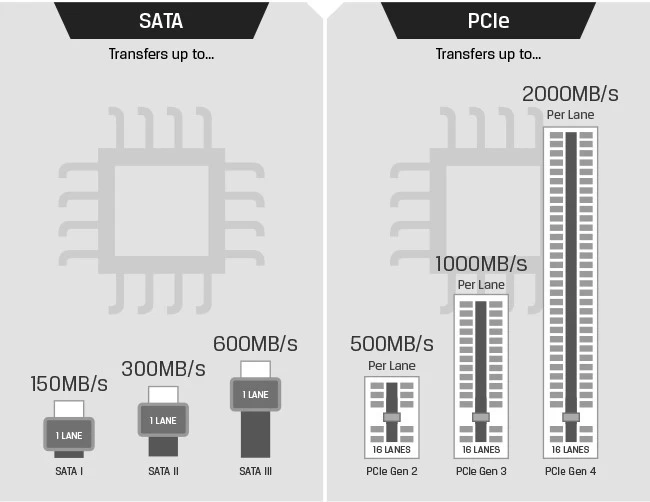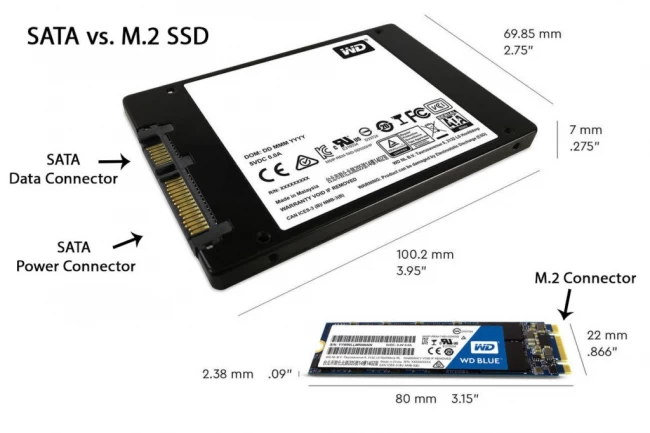List of content you will read in this article:
Since the inception of computers, storage mediums have improved and evolved over time. From punch cards to floppy disks and hard drives, we have been attempting to store more information on the smallest devices possible. Size is not the only factor we are trying to improve though. The speed with which data can be transferred is another thing we are trying to increase for the purposes of performance.
Well, there is a new player in the field; one that absolutely dominates the previous victors. NVMe SSDs are a relatively new storage medium that simply blows all others out of the waters. Before that, however, we will shortly introduce the older SATA standard.
What is SATA?

SATA stands for Serial ATA is an older technology that has a bus type similar to PCI-express, however, is way slower. It was originally introduced more than two decades ago, in the year 2000, and replaced PATA (i.e. Parallel ATA), which was the storage standard at the time.
Back then, SSDs were not widely used by consumers, and thus this standard was designed with only traditional hard-disk drives in mid (i.e., HDDs). It did, however, offer incredible speed advantages over the previous PATA standard.
Once high-capacity SSDs became cheaper and more accessible to the average consumer, the SATA standard turned into a bottleneck for the flash memory, as it was not designed for it.
What is NVMe?

NVMe stands for non-volatile memory express and is a storage protocol that defines a command set and feature set for PCIe-based solid-state drives (SSDs) . NVMe was created to accelerate the transfer of data between enterprise and client systems and SSDs over a high-speed PCIe (Peripheral Component Interconnect Express) bus.
What is PCIe?

Now that we looked into the new NVMe standard, let us talk about the peripheral component interconnect express interface standard (i.e., PCIe), which the NVMe SSDs are connected to. It is an interface standard used for connecting high-speed components, primarily GPUs (graphic cards), RAID controllers, Wi-Fi cards, and SSDs. The amount and types of PCIe slots your PC contains solely depend on the motherboard installed within it.
There are different physical configurations for PCIe slots which are x1, x4, x8, x16. These numbers simply signify how many lanes said slot has. Typically, a modern motherboard will contain at least 2 x16 slots and 2 x4 slots. The x16 slots are most often used to connect GPUs and x4 slots are the ones reserved for SSDs and other components.
NVMe is a new standard
An older standard by name AHCI (Advanced Host Controller Interface) was designed for hard drives. Since the introduction of non-volatile storage (e.g. NAND and MRAM), the industry must have developed a software interface that abolishes the limits of AHCI.
The main benefits of NVMe-based PCIe SSDs over SAS-based and SATA-based SSDs are, reduced latency in the host software stack, higher input/output operations per second (IOPS), and potentially lower power consumption depending on the form factor and the number of PCIe lanes in use.

NVMe can support SSDs that use different types of non-volatile memory, including NAND flash and the 3D XPoint technology developed by Intel and Micron Technology. Supported form factors include add-in PCIe cards, M.2 SSDs, and U.2 2.5-inch SSDs. NVMe reference drivers are available for a variety of operating systems, including Windows and Linux.
Differences between BUSs in data transfer

Using 16 lanes, PCIe Gen4 can transfer data at speeds up to 32,000 MB/s.
Differences between storage protocols

NVMe M.2 SSDs
Lastly, let us introduce to you the latest trend in computer building and laptop manufacturing. Unlike SATA and NVMe, M.2 is not a storage standard but a form factor for SSDs. This means that both NVMe and SATA SSDs can be in M.2 size, however, the latter is not commonly used anymore.
Most modern motherboards will have at least one M.2 PCIe socket; however, older ones might have an M.2 SATA socket. This form factor is getting more and more popular in small system builds and laptop manufacturing as the price for PCIe M.2 SSDs drops with time.
Here’s why:

As you can see, the size difference is truly magnifying and since M.2 SSDs plug directly into the motherboard and draw power from it, there is no need for extra SATA data or power cables. In fact, the two SSDs pictured above offer the exact same performance (the M.2 SSD, in this case, is also using the SATA standard) with almost identical prices.
Of course, if you have a PCIe M.2 slot on your motherboard, we strongly recommend you to spend more for the premium of the new storage standard and get an NVMe M.2 SSD instead as all the advantages we have mentioned before also apply to the M.2 form factor.
Conclusion
We know that we mentioned a lot of technical terms in this article, however, this was necessary to truly understand and compare NVMe to its predecessor. To summarize in layman’s terms, upgrading from a SATA SSD to an NVMe SSD can increase the performance of your device tenfold. If you are upgrading from a traditional HDD to an NVMe SSD, you will genuinely feel as if your machine has turned into a supercomputer, as in some cases, the performance might multiply as much as 800 times.
We hope you now have a better idea of what storage device will serve you best and if you have any questions or suggestions, please leave them in the comments down below.
